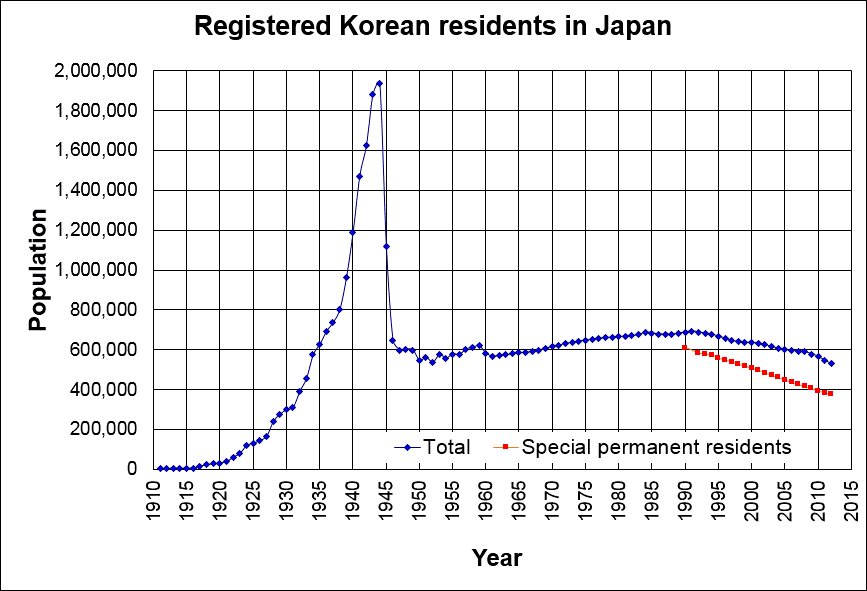|
Koreans
Koreans ( South Korean: , , North Korean: , ; see names of Korea) are an East Asian ethnic group native to the Korean Peninsula. Koreans mainly live in the two Korean nation states: North Korea and South Korea (collectively and simply referred to as just Korea). They are also an officially recognized ethnic minority in other Asian countries; such as China, Japan, Kazakhstan and Uzbekistan. Koreans also form sizeable communities in Europe, specifically in Russia, Germany, United Kingdom, and France. Over the course of the 20th century, Korean communities have also formed in the Americas (especially in the United States and Canada) and Oceania. As of 2021, there were an estimated 7.3 million ethnic Koreans residing outside Korea. Etymology South Koreans refer to themselves as Hanguk-in( Korean: 한국인, Hanja: 韓國人) or Hanguk-saram ('' Korean: 한국 사람''), both of which mean "people of the Han". When including members of the Korean diaspora, Koreans oft ... [...More Info...] [...Related Items...] OR: [Wikipedia] [Google] [Baidu] |
Koreans In Japan
comprise ethnic Koreans who have permanent residency status in Japan or who have become Japanese citizens, and whose immigration to Japan originated before 1945, or who are descendants of those immigrants. They are a group distinct from South Korean nationals who have emigrated to Japan after the end of World War II and the division of Korea. They currently constitute the second largest ethnic minority group in Japan after Chinese immigrants, due to many Koreans assimilating into the general Japanese population. The majority of Koreans in Japan are , often known simply as , who are ethnic Korean permanent residents of Japan. The term Zainichi Korean refers only to long-term Korean residents of Japan who trace their roots to Korea under Japanese rule, distinguishing them from the later wave of Korean migrants who came mostly in the 1980s, and from pre-modern immigrants dating back to antiquity who may themselves be the ancestors of the Japanese people. The Japanese word "Zainic ... [...More Info...] [...Related Items...] OR: [Wikipedia] [Google] [Baidu] |
Koreans In The Philippines
Koreans in the Philippines, largely consisting of expatriates from South Korea and people born in the Philippines with Korean ancestry, form the second largest Korean diaspora community in Southeast Asia and the 14th-largest in the world, after Koreans in Kazakhstan and before Koreans in Vietnam. As of 2013, statistics of South Korea's Ministry of Foreign Affairs and Trade recorded their population at 88,102 people, a fall of 31% since 2009 after a period of rapid growth in the population in the preceding decade. Many South Koreans living in the Philippines are attracted to the low cost of English-language education and housing, both significantly cheaper than those offered in their native South Korea. The warmer climate is yet another motivating factor for the recent surge in migration. The Philippines is also a popular destination for retired South Koreans on fixed pensions; the Filipino government actively promotes the settlement of South Korean retirees in the country becaus ... [...More Info...] [...Related Items...] OR: [Wikipedia] [Google] [Baidu] |
Koreans In China
Koreans in China (), Korean Chinese (), Joseonjok, Chosŏnjok (), or Chaoxianzu (), are Chinese by nationality and are Koreans by ethnicity (with either full or partial Korean ancestry). A majority of the chaoxianzu are descendants of immigrants from Korean peninsula from recent immigration. The Chinese government officially recognize them as one of the 56 ethnicities being part of the 55 ethnic minorities in China. They are the 13th largest minority group in China. Their total population was estimated at 1,923,842 and 1,830,929 according to the 2010 Chinese census. High levels of emigration to the Republic of Korea for better economic and financial opportunities, which has conversely reported a large increase of Korean Chinese in Korea, are the likely cause of the drop in China. Most of them live in South Korea and Yanbian Korean Autonomous Prefecture. They are also located in Heilongjiang, Liaoning, and Inner Mongolia Autonomous Region. The population of Koreans in Chi ... [...More Info...] [...Related Items...] OR: [Wikipedia] [Google] [Baidu] |
Korean Diaspora
The Korean diaspora (South Korea: or , North Korea: or ) consists of around 7.3 million people, both descendants of early emigrants from the Korean Peninsula, as well as more recent emigres from Korea. Around 84.5% of overseas Koreans live in just five countries: China, the United States, Japan, Canada, and Uzbekistan. Other countries with greater than 0.5% Korean minorities include Brazil, Russia, Kazakhstan, Vietnam, the Philippines, and Indonesia. All these figures include both permanent migrants and sojourners. Terminology There are currently a number of official and unofficial appellations used by the authorities of the two Korean states as well as a number of Korean institutions for Korean nationals, expatriates and descendants living abroad. Thus, there is no single name for the Korean diaspora. The historically used term ''gyopo'' (교포/僑胞, also spelled ''kyopo'', meaning "nationals") has come to have negative connotations as referring to people who, as a result ... [...More Info...] [...Related Items...] OR: [Wikipedia] [Google] [Baidu] |
Koreans In Uzbekistan
Koryo-saram ( ko, 고려사람; russian: Корё сарам; uk, Корьо-сарам) is the name which ethnic Koreans in the post-Soviet states use to refer to themselves. The term is composed of two Korean words: "", a historical name for Korea, and "", meaning "person" or "people". Approximately 500,000 ethnic Koreans reside in the former Soviet Union, primarily in the now-independent states of Central Asia. There are also large Korean communities in Southern Russia (around Volgograd), Russian Far East (around Vladivostok), the Caucasus and southern Ukraine. These communities can be traced back to the Koreans who were living in the Russian Far East during the late 19th century. There is also a separate ethnic Korean community on the island of Sakhalin, typically referred to as Sakhalin Koreans. Some may identify as Koryo-saram, but many do not. Unlike the communities on the Russian mainland primarily descended from Koreans who arrived in the late 19th century and early 20 ... [...More Info...] [...Related Items...] OR: [Wikipedia] [Google] [Baidu] |
Koreans In Russia
Koryo-saram ( ko, 고려사람; russian: Корё сарам; uk, Корьо-сарам) is the name which ethnic Koreans in the post-Soviet states use to refer to themselves. The term is composed of two Korean words: "", a historical name for Korea, and "", meaning "person" or "people". Approximately 500,000 ethnic Koreans reside in the former Soviet Union, primarily in the now-independent states of Central Asia. There are also large Korean communities in Southern Russia (around Volgograd), Russian Far East (around Vladivostok), the Caucasus and southern Ukraine. These communities can be traced back to the Koreans who were living in the Russian Far East during the late 19th century. There is also a separate ethnic Korean community on the island of Sakhalin, typically referred to as Sakhalin Koreans. Some may identify as Koryo-saram, but many do not. Unlike the communities on the Russian mainland primarily descended from Koreans who arrived in the late 19th century and early 20 ... [...More Info...] [...Related Items...] OR: [Wikipedia] [Google] [Baidu] |
Koreans In Ukraine
Koryo-saram ( ko, 고려사람; russian: Корё сарам; uk, Корьо-сарам) is the name which ethnic Koreans in the post-Soviet states use to refer to themselves. The term is composed of two Korean words: "", a historical name for Korea, and "", meaning "person" or "people". Approximately 500,000 ethnic Koreans reside in the former Soviet Union, primarily in the now-independent states of Central Asia. There are also large Korean communities in Southern Russia (around Volgograd), Russian Far East (around Vladivostok), the Caucasus and southern Ukraine. These communities can be traced back to the Koreans who were living in the Russian Far East during the late 19th century. There is also a separate ethnic Korean community on the island of Sakhalin, typically referred to as Sakhalin Koreans. Some may identify as Koryo-saram, but many do not. Unlike the communities on the Russian mainland primarily descended from Koreans who arrived in the late 19th century and early 20 ... [...More Info...] [...Related Items...] OR: [Wikipedia] [Google] [Baidu] |
Koreans In Kyrgyzstan
Koryo-saram ( ko, 고려사람; russian: Корё сарам; uk, Корьо-сарам) is the name which ethnic Koreans in the post-Soviet states use to refer to themselves. The term is composed of two Korean words: "", a historical name for Korea, and "", meaning "person" or "people". Approximately 500,000 ethnic Koreans reside in the former Soviet Union, primarily in the now-independent states of Central Asia. There are also large Korean communities in Southern Russia (around Volgograd), Russian Far East (around Vladivostok), the Caucasus and southern Ukraine. These communities can be traced back to the Koreans who were living in the Russian Far East during the late 19th century. There is also a separate ethnic Korean community on the island of Sakhalin, typically referred to as Sakhalin Koreans. Some may identify as Koryo-saram, but many do not. Unlike the communities on the Russian mainland primarily descended from Koreans who arrived in the late 19th century and early 20 ... [...More Info...] [...Related Items...] OR: [Wikipedia] [Google] [Baidu] |
Koreans In Kazakhstan
Koryo-saram ( ko, 고려사람; russian: Корё сарам; uk, Корьо-сарам) is the name which ethnic Koreans in the post-Soviet states use to refer to themselves. The term is composed of two Korean words: "", a historical name for Korea, and "", meaning "person" or "people". Approximately 500,000 ethnic Koreans reside in the former Soviet Union, primarily in the now-independent states of Central Asia. There are also large Korean communities in Southern Russia (around Volgograd), Russian Far East (around Vladivostok), the Caucasus and southern Ukraine. These communities can be traced back to the Koreans who were living in the Russian Far East during the late 19th century. There is also a separate ethnic Korean community on the island of Sakhalin, typically referred to as Sakhalin Koreans. Some may identify as Koryo-saram, but many do not. Unlike the communities on the Russian mainland primarily descended from Koreans who arrived in the late 19th century and early 20 ... [...More Info...] [...Related Items...] OR: [Wikipedia] [Google] [Baidu] |
Korean Americans
Korean Americans are Americans of Koreans, Korean ancestry (mostly from South Korea). In 2015, the Korean-American community constituted about 0.56% of the United States population, or about 1.82 million people, and was the fifth-largest Asian Americans subgroup, after the Chinese Americans, Filipino Americans, Indian Americans, and Vietnamese Americans communities. The U.S. is home to the largest Korean diaspora community in the world. Demographics According to the 2010 United States Census, 2010 Census, there were approximately 1.7 million people of Korean descent residing in the United States, making it the country with the second-largest Korean population living outside Korea (after the People's Republic of China). The ten states with the largest estimated Korean American populations were California (452,000; 1.2%), New York (state), New York (141,000, 0.7%), New Jersey (94,000, 1.1%), Virginia (71,000, 0.9%), Texas (68,000, 0.3%), Washington (state), Washington (62,400, ... [...More Info...] [...Related Items...] OR: [Wikipedia] [Google] [Baidu] |
Koreans In India
There is a small Korean community in India, consisting largely of South Korean expatriate professionals and their families, as well as some missionaries and international students at Indian universities. Migration history In 526 CE, Korea monk Gyeomik, went to India to learn Sanskrit and study the monastic discipline Vinaya, and founded the Gyeyul () branch of Buddhism that specializes in the study of Vinaya which derives directly from the Indian ''Vinaya School''. In 673 CE, Chinese Buddhist pilgrim, Yijing who reached India, recorded that the people of Indian subcontinent were familiar with Korea's customs and beliefs and they regarded Koreans as "worshipers of the rooster". This concept about Koreans was grounded in a legend of the Silla dynasty. By early 1950s, migration of Koreans to India had commenced; the Korean Association of India was founded in that decade in New Delhi by three South Koreans who had gone into exile after being released from prison in their home coun ... [...More Info...] [...Related Items...] OR: [Wikipedia] [Google] [Baidu] |
Koreans In Germany
Koreans in Germany numbered 31,248 individuals , according to the statistics of South Korea's Ministry of Foreign Affairs and Trade. Though they are now only the 14th-largest Korean diaspora community worldwide, they remain the second-largest in Western Europe, behind the rapidly growing community of Koreans in the United Kingdom. As of 2010, Germany has been hosting the second largest number of Koreans residing in Western Europe if one excludes Korean sojourners (students and general sojourners). The largest community of Koreans is situated in the Frankfurt-Rhine Main Area, with 5,300 residents. This area also contains German and European headquarters of large Korean companies such as Kia Motors, Hyundai, Samsung Electronics, LG International, SK Network, Nexen Tire. History South Koreans Some students, nurses, and industrial trainees from South Korea had already been in West Germany in the late 1950s. However, mass migration did not begin until the 1960s, when West Germany ... [...More Info...] [...Related Items...] OR: [Wikipedia] [Google] [Baidu] |





